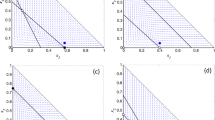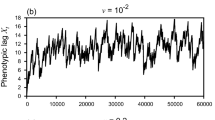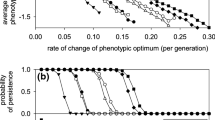Abstract
Eco-evolutionary models commonly assume that traits are normally distributed in a population, and that the trait bounds do not influence the adaptation of traits. However, recent empirical evidence suggests that at least some traits are not normally distributed, and there is theoretical support for the view that trait bounds can be fundamental to trait adaptation. These attributes suggest that a beta distribution, which can accommodate unbounded (i.e. normal), singly bounded (i.e. gamma) or doubly bounded (beta) trait distributions, may be an appropriate alternative assumption for eco-evolutionary models. We develop an evolutionary model that represents how the mean values of a population’s traits change. Implementation of the model requires assumptions to be made regarding the relative fitness of the individuals in the population, and how their traits are distributed within natural bounds. We compare the numerical results of “population” models that evolve a plant population and the means of its two traits using our eco-evolutionary equations with those of “phenotype” models that evolve 10,000 phenotypes, each defined by a pair of trait values, of a plant population. The phenotype models do not assume any particular trait distribution or fitness, and allow phenotypes to wax and wane according to their ability to compete with other phenotypes in the population for a finite resource. Comparison of the trait distributions obtained by solving 3 coupled population odes with those obtained by solving 10,000 coupled phenotype odes reveals very good agreement between the approaches for each of four mortality functions. Further, it supports the ubiquity of the beta distribution in describing evolutionary processes in populations. An advantage of the simple population model is that it provides insights into why particular results are obtained, which augments the predictive power of the modelling, suggesting that in fact a simplified, abstracted modelling approach is sometimes preferable to the detailed, complicated alternative.





Similar content being viewed by others
References
Abrams P (1999) The adaptive dynamics of consumer choice. Am Nat 153:83–97
Abrams P, Matsuda H (2004) Consequences of behavioral dynamics for the population dynamics of predator-prey systems with switching. Popul Ecol 46:13–25
Abrams P, Matsuda H, Harada Y (1993) Evolutionarily unstable fitness maxima and stable fitness minima of continuous traits. Evol Ecol 7:465–487
Chesson P (2000) Mechanisms of maintenance of species diversity. Annu Rev Ecol Syst 31:343–366
Cortez M, Ellner S (2010) Understanding rapid evolution in predator-prey interactions using the theory of fast-slow dynamical systems. Am Nat 176(5):E109–E127
Cortez M, Patel S (2017) The effects of predator-evolution and genetic variation on predator-prey population-level dynamics. B Math Biol 79:1510–1538
Coutinho R, Klauschies T, Gaedke U (2016) Bimodal trait distributions with large variances question the reliability of trait-based aggregate models. Theor Ecol 9:389–408
Cropp R, Norbury J (2015) Population interactions in ecology: a rule-based approach to modeling ecosystems in a mass-conserving framework. SIAM Rev 57(3):437–465
Cropp R, Norbury J (2018) Obligate mutualism in an extended consumer-resource framework. Yale J Biol Med 91:375–389
Downing A, Hajdu S, Hjerne O, Otto S, Blenckner T, Larsson U, Winder M (2014) Zooming in on size distribution patterns underlying species coexistence in Baltic Sea phytoplankton. Ecol Lett 17:1219–1227
Fisher R (1930) The genetical theory of natural selection. The Clarendon Press, Oxford
Fussman G, Loreau M, Abrams P (2007) Eco-evolutionary dynamics of communities and ecosystems. Funct Ecol 21(3):465–477
Gaedke U, Klauschies T (2017) Analysing the shape of observed trait distributions enables a data-based moment closure of aggregate models. L&O Methods 15:979–994
Grafen A (2015) Biological fitness and the fundamental theorem of natural selection. Am Nat 186(1):1–14
Havlicek T, Carpenter S (2001) Pelagic species size distributions in lakes: are they discontinuous? Limnol Oceanogr 46:1021– 1033
Johnson D (1997) The triangular distribution as a proxy for the beta distribution in risk analysis. Statistician 46(3):387–398
Klauschies T, Coutinho R, Gaedke U (2018) A beta distribution-based moment closure enhances the reliability of trait-based aggregate models for natural populations and communities. Ecol Model 381:46–77
Lande R (1976) Natural selection and random genetic drift in phenotype evolution. Evolution 30:314–334
Lande R (1982) A quantitative genetic theory of life history evolution. Ecology 63:607–615
Law A, Kelton W (1982) Simulation Modelling and Analysis. McGraw-Hill, New York
Loreau M (2010) From Populations to Ecosystems Monographs in Population Biology, vol 46. Princeton University Press, Woodstock
Merico A, Bruggeman B, Wirtz K (2009) A trait-based approach for downscaling complexity in plankton ecosystem models. Ecol Model 220:3001–3010
Norberg J, Swaney D, Dushoff J, Lin J, Casagrandi R, Levin S (2001) Phenotypic diversity and ecosystem functioning in changing environments: a theoretical framework. PNAS 98(20):11,376– 11,381
Pham-Gia T, Duong Q (1989) The generalised beta- and f-distributions in statistical modelling. Math Comput Model 12(12):1613–1625
Price A, Patterson N, Plenge R, Weinblatt M, Shadick N, Reich D (2006) Principal components analysis corrects for stratification in genome-wide association studies. Nat Genet 38(8):904–909
Tilman D (1977) Resource competition between planktonic algae: an experimental and theoretical approach. Ecology 58:338– 348
Tilman D (1981) Tests of resource competition theory using four species of Lake Michigan algae. Ecology 62:802–815
Vitousek P, Matson P (2012) Nutrient cycling and biogeochemistry. In: Levin S. (ed) The Princeton guide to ecology, vol 1. Princeton University Press, Princeton New Jersey, pp 330–339
Wright S (1950) Genetical structure of populations. Nature 166(4215):247–249
Acknowledgements
The authors thank the two anonymous reviewers for their thoughtful and useful comments.
Author information
Authors and Affiliations
Corresponding author
Ethics declarations
The research underpinning this manuscript did not involve human participants or animals. Informed consent was not required.
Conflict of interest
The authors declare that they have no conflict of interest.
Appendices
Appendix 1: Resource-limited ecological modelling
Here we outline the framework that imposes ecological bounds on the trait values in the eco-evolutionary model—a detailed exposition of the framework is provided in Cropp and Norbury (2015). We consider n living populations in an ecosystem that has a limiting resource (often a food web limited by nutrient, but a limiting resource might also be light, for example) represented by the variables xi, \(i=1,2,\dots ,n\). The rate of change of each population may be written in the general form:
where n is the number of populations modelled and Υ is a set of parameters that quantify how the populations interact with each other and their environment. The system conserves the total quantity of the limiting resource, so implicit in the model is an additional equation, not of the form of Eq. (7), which keeps track of the size of the resource pool R, often an inorganic nutrient pool N. The functions \(f_{i}(x_{1},x_{2},\dots ,x_{n};{\Upsilon })\), which for convenience we shall refer to as fi, are key to the ecological and evolutionary dynamics of the system.
The resource-limited ecosystem modelling approach is implemented by the following process:
-
We identify a limiting resource, most commonly a limiting nutrient, which we use as a common currency to measure all populations. We sum the limiting nutrient cycling in both the living populations and the nonliving nutrient pool, and scale all the (living and nonliving) variables by this total;
-
Each population grows (dies) according to the constraints of the other populations and the environment, represented here in its simplest form by the nonliving nutrient pool, independently of how we measure the populations and the scale of the ecosystem;
-
The mass of limiting nutrient is conserved as it flows through the food web: we assume that immigration equals emigration and nutrient influx equals nutrient efflux (most delineated ecosystems recycle at least 90% of their limiting nutrient Loreau 2010; Vitousek and Matson 2012);
-
The growth of every population is explicitly limited by the resources available to it: when its resources are maximal the population increases, when its resources are zero, the population decreases;
-
Negative nutrient concentrations are not permitted, that is, when any living population or the nutrient in the abiotic resource pool are zero, these variables can only increase.
The first three principles ensure the setup of model ecosystem equations that are internally consistent. The fourth provides checks to ensure that the populations have sensible properties and that they are viable but not immortal.
The final principle ensures that there is no capacity for living populations to “borrow” resources from the environment, and reflects that the total amount of limiting nutrient is finite. We note that this condition does not apply to other nutrients or resources, solely to the limiting resource. Also note that the fifth condition, which precludes negative values, does not imply that the system may take negative values and that we over-ride these, as is apparently done in some complex ecological simulation model examples. The condition in our example arises from the structure of the equations and is a property of the system. Finally, note that we usually scale all limiting nutrient amounts by the total amount in the ecosystem, or food web. Then our populations P (and N) are measured as fractions or percentages. Time t is scaled to be days which, in the case of microscopic plants that we use as a model system, equates approximately to generations.
Appendix 2: Resource-limited ecological modelling
Consider a population xi(t) divided into phenotypes classified by the trait parameter u which continuously extends from 0 to 1 (after scaling suitably), for each value of time t > 0. We define X(t, u) to be the mass measure of limiting nutrient across the phenotype range, at each t, measured so that:
Then:
so that X(t, u) defines a cumulative distribution and ∂X/∂u a probability density function on u in 0 < u < 1.
We can now define a trait mean ui and a trait variance \({\sigma _{i}^{2}}\) (at any time t > 0) by using this probability distribution on u. So we have:
because \({{\int \limits }_{0}^{1}} u_{i}(u-u_{i}) \frac {\partial X}{\partial u} du=0\). We now want to find an expression for the change of the trait mean ui as time evolves, when the variance \({\sigma _{i}^{2}}(t)\) of the trait distribution in the population remains small.
Phenotype dynamics are given by:
where the life function fi for the population xi is here written in terms of all other populations \(\underline {x}\) and parameters \(\underline {\Upsilon }\), but only the trait u is adapting together with X(t, u), which measures the phenotype share of the xi population at each t > 0. To recover the population dynamics equation we sum all the phenotype behaviours by summing Eq. (11), using Eq. (9),
The remainder \( \mathfrak {R}_{1}\) in Eq. (12) is small when the trait variance \({\sigma _{i}^{2}}\) is small, as discussed later. Next we differentiate Eq. (10a) with respect to t:
Substitute Eqs. (12) and (11):
where we have used Eq. (10b) for the variance. The remainder term \(\mathfrak {R}_{3}\) has a similar form to \(\mathfrak {R}_{2}\), and also is small when the variance is small. It arises from:
where u∗ lies between ui and u, and where the second derivative of fi is bounded. The terms \(\mathfrak {R}_{1}\), \(\mathfrak {R}_{2}\), and \(\mathfrak {R}_{3}\) are all small because of the form of the integral of the probability measure in Eq. (10b) when the variance is small and the function fi is smoothly twice differentiable in all its variables.
Appendix 3: Resource-limited ecological modelling
We implement the equations describing how the aggregate properties of trait distributions change (see derivations in the Appendix B), assuming that beta distributions provide the greatest utility in describing many trait distributions. We obtain different evolutionary equations for the mean value of a trait u depending on whether or not the ecosystem constraints dictate that the trait has bounds:
Here, f is the function that describes the per-capita growth of the population that contains the trait with mean value ui. The term L = uU − uL provides the appropriate trait variable scaling for the equations that are singly bounded or unbounded, where uL and uU are the lower and upper bound of the trait distribution respectively. In the case of the normal distribution, uU and uL are notional symmetric values, for example the mean ui plus or minus a standard deviation σ.
The variances of the trait distributions are given by σ2 = L2/(α + β + 1) (notionally a normal distribution), (ui − uL)L/(α + β + 1) and (uU − ui)L/(α + β + 1) (notionally gamma or skewed beta distributions), and (uU − ui)(ui − uL)/(α + β + 1) for the beta distribution. Note that (uU − ui)(ui − uL)/(α + β + 1) is an exact expression for the variance of a beta distribution, but that (ui − uL)L/(α + β + 1) and (uU − ui)L/(α + β + 1) are approximations as α << β and α >> β respectively, for α + β >> 1. Note that in some cases the trait scalings and dimensions may be included in the ecosystem equations, and then the trait equations just involve standard beta distributions. We use this approach in this paper.
Appendix 4: Conservation of α + β?
The denominators of the variances in Eq. (16) contain the sum α + β + 1, where α and β are commonly referred to as shape parameters of the beta distribution. The sum α + β > 0 has several interpretations, for example as a notional sample size in Bayesian statistics. Here, we consider its application in genetics where it may be interpreted as a statistical estimate of the allele frequencies in the components of a sub-divided population. We somewhat abstract that interpretation to phenotypes:
where F is Wright’s genetic distance between two populations (Wright 1950). Small values of F indicate little differentiation between allele frequencies (phenotypes or trait values) within a population, implying a high level of mixing within the population. Small values of F imply large values of α + β, so that the related trait distribution has a small variance and is tightly focussed about the mean.
There likely exist instances where the mixing properties of a population are independent of the dynamics of a particular trait, in which case the sum α + β would be constant over simulations of trait evolution. Populations with large, constant values of α + β may remain symmetrically distributed away from their bounds under stabilising selection, or move homogeneously to one side or the other of their trait distribution under directional selection, but not split into two distinct phenotypes as occurs under disruptive selection. We observe directional selection in the simulations of both models. We chose to maintain α + β constant in the population model, but the phenotype model does not. If we assume that the phenotype model is the “reality” that we test the population model against, then an interesting question is how does α + β, or Wright’s F, actually change?
Rights and permissions
About this article
Cite this article
Cropp, R., Norbury, J. Modelling the evolution of naturally bounded traits in a population. Theor Ecol 14, 255–268 (2021). https://doi.org/10.1007/s12080-020-00495-2
Received:
Accepted:
Published:
Issue Date:
DOI: https://doi.org/10.1007/s12080-020-00495-2




